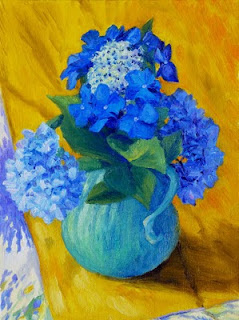 |
| Old Ellicott City Fire Station, oils on canvas panel, 9 " 12." |
 |
| Painting the Firehouse from Main Street. Photo by Vesselinka Warren |
|
|
Last weekend (Aug 28-29) was the "Paint It"
plein air in Ellicott City. There were about thirty artists juried for the event and it was my first juried
plein air competition. We had two days to produce our paintings, then bring the framed paintings to the Howard County Center for the Arts (
Hocoarts.org) for the exhibition.
On Saturday morning I headed over with the idea of starting with the old railroad station, now operated as a museum. I had not realized that the museum did not open until 11 AM. I had my rolling cart to drag my ever-increasing art supplies, so I decided to use the time painting a street scene in front of near-by St. Paul's Church.
The day was sunny, and getting hotter. By the time I finished my first painting at noon, standing in the sun was unbearable, and my painting was nothing I cared to show. Chalk that one up to a warm-up. An old friend and fellow artist, Mary Jo Tydlacka, walked by and saw me--she was painting another view of this scene from the porch of the house next to the church, and she had been smart enough to set up in the shade.
 |
| Ellicott City Station, oils on canvas panel, 11" x14." |
After gathering my stuff, I rolled my cart over to the
B&O Railroad Museum to ask permission to set up on the platform. The lady behind the counter said that would be fine as long as I paid the entry fee of $5 and didn't block anyone. Done! I asked if I could leave my stuff there to go pick up a sandwich across the street, ate quickly and was back at the station before one o'clock. Another attendant opened a gate to the ramp leading up to the platform so I could get my cart up.
The afternoon passed quickly while I painted. Quite a number of folks, many with children in tow, came over to see what I was doing and asked questions. I explained about the Ellicott City Paint It and urged them to come see the exhibit later on. One little girl in particular was fascinated and stopped to watch me for a long time.
I finished around four, utterly dehydrated and done in by the heat. Where were those volunteers from the tourism office who were supposed to bring us water bottles from time to time? I left the station and got everything back to my car, and drove to the parking lot near the
Howard County Tourism Office to get some water. I debated whether to try for one more painting or call it a day--eight hours on my feet in that heat was just about enough.
After drinking a bottle of iced water I felt better and walked about looking for another painting. There were two pastel artists right across the street from the Tourism Office doing some very nice pieces. At the corner was an antique shop that had several chairs set out on the sidewalk, and I sat on one to rest my aching feet and take in the view. The
Old Ellicott City Fire Station (again now a museum) perched on a hill above Main Street would make a nice painting.
A man came out of the store and started to bring things in. It was almost five so I asked him if he was closing soon. At five, he said. Perfect! I could bring my own chair from the car and sit here. The crowds thinned out a bit after the stores closed. I was deep into painting when a lady walking by asked me if I would mind having my photo taken. Of course not, I said. Her charming accent betrayed her foreign origin and I asked where she was from--Bulgaria--we chatted a bit and she offered to send me a copy of the photo so I could use it here.
By the time I finished my painting the sun was long down and it was getting dark--it was eight o'clock and I was completely exhausted. I had barely the energy to drive home, eat some dinner and hit the sack. I was asleep in an instant.
 |
| Patapsco River Bridge, oils on canvas panel, 11" x 14" |
The next morning I left the house earlier, hoping to use the cool of the day to paint by the river. It was a little hazier than the previous day, but the early light was beautiful on the water and the rocks. Deborah and Maria, the two pastel artists I'd talked with before were there, and shortly after I started, another artist came by. Janice had begun her painting the day before but had not finished it, so I moved over a bit to allow her some room. Her painting was gorgeous and it received a well-deserved award. She also made a few helpful comments about mine that I really appreciated. Overall, I think this was the most successful of my four.
Quitting around noon, this time I was ready to head home and frame my wet paintings (always a tricky proposition) to hand them in that evening for the exhibition. On Monday evening there was a reception and awards ceremony--there were a lot of wonderful paintings there and all are for sale. Go see the show at the
Howard County Center for the Arts; it will be up until October 15.
















































